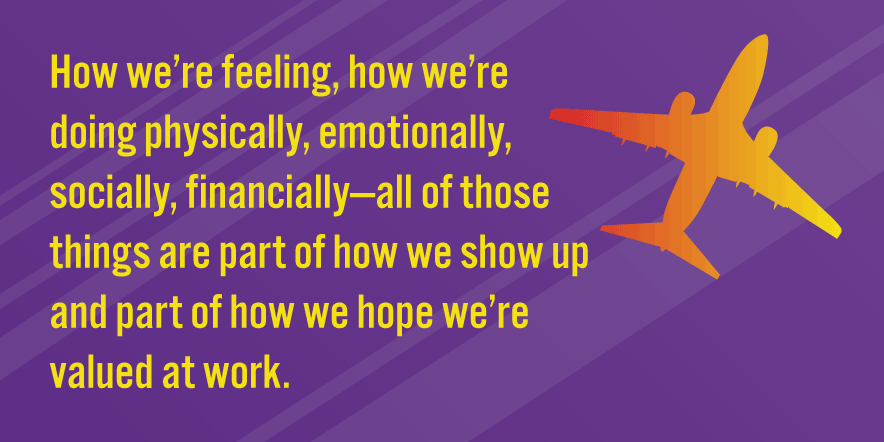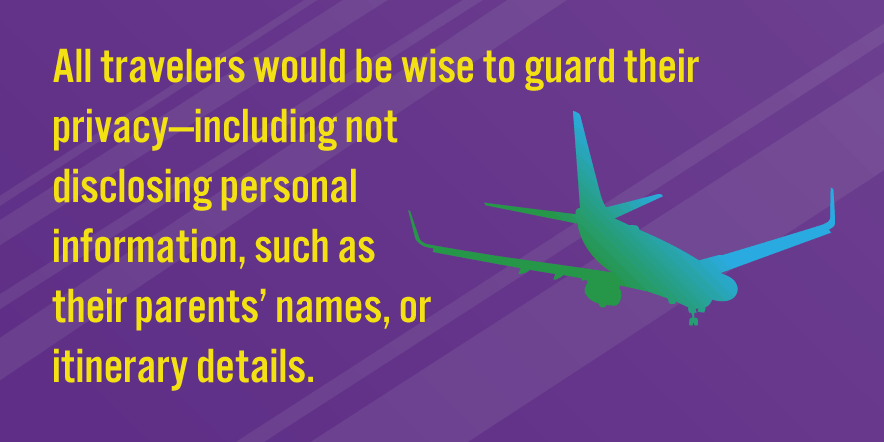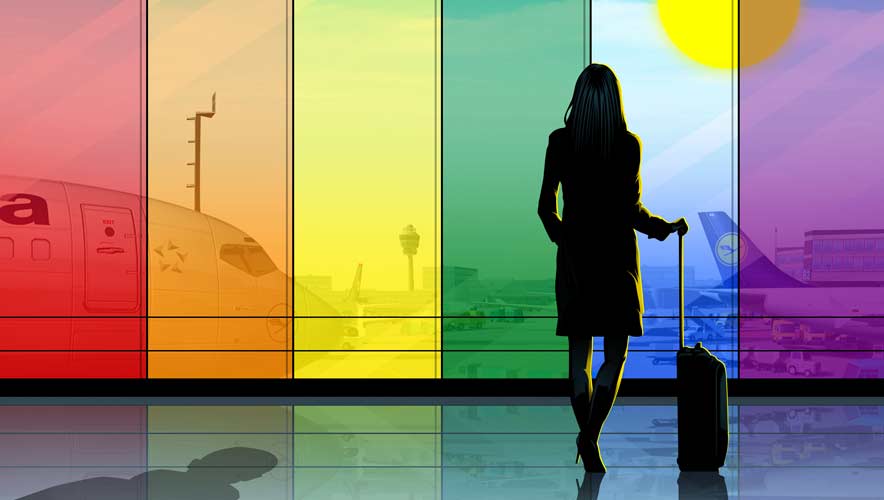Out and at Risk: Protecting LGBTQ+ and Other Minority Travelers
How are you supporting your employees? Support goes beyond providing sufficient tools in the face of supply chain snags, remaining up to date on cybersecurity and database protections, or providing a sense of community and culture in an increasingly hybrid workplace. Are you going even further to welcome employees’ unique identities while they are in the office, at home, or traveling? Or are you asking them to suppress themselves?
As the modern workplace evolves, businesses’ cultures are shifting, too. Organizations now often seek to welcome employees’ authentic selves at work, rather than treating discussions or presentations of certain identities or traits as taboo.
“The reality is that inclusive workplaces improve the overall wellbeing of their employees,” said Natasha Jamal, a senior consultant for Gallup, in an episode of the podcast Called to Coach.
“So, when we think about bringing that authentic self to work, our wellbeing is a critical component of that authentic self,” Jamal said. “How we’re feeling, how we’re doing physically, emotionally, socially, financially—all of those things are part of how we show up and part of how we hope we’re valued at work.”
Findings from other Gallup surveys, including Advancing DEI Initiatives: A Guide for Organizational Leaders, support the view that “employees who feel included…are more engaged at work than those who do not.”
Research from McKinsey supports similar observations, with the firm noting that since roughly 2016, diverse companies are more likely to out-earn industry peers. When a company and its leaders support diversity and inclusive commitments, it can significantly benefit the organization’s performance.
“Organizations can ensure that they hold onto their top talent by monitoring the demographic profile of their changing workforce and ensuring that diverse talent isn’t lost,” according to Diversity Still Matters. The McKinsey “research on Latin America showed that companies perceived as committed to diversity are about 75 percent more likely to report a pro-teamwork leadership culture.”
And organizations are adapting again—this time to a work environment where COVID-19 and its surfeit of variants have become more manageable. Companies are considering adjustments to the office, like hybrid work models, as well as adjustments to business travel.
As travel climbs back toward pre-pandemic levels, spurred by both business and leisure, companies must consider their internal travel risk management programs, especially for employees who identify with any marginalized community.
While some advice can be generally applied to travelers at-large, assessing an individual employee’s risk is unlikely to produce effective security considerations if operating under a one-size-fits-all program. And while travel security programs may attempt to apply an umbrella approach, many risks do not fit into neat categories and can put different travelers at high risk if they are unprepared. Women, LGBTQ+ people, religious minorities, and some ethnicities are of particular concern.
The Trans Murder Monitoring (TMM) project reported that 375 transgender and gender-diverse people were murdered between 1 October 2020 and 30 September 2021, a 7 percent increase over the previous year.
“Brazil remains the country that reported the majority of the murders (125), followed by Mexico (65) and the United States (53),” according to the November 2021 TMM report. These numbers only account for reported homicides, so the true figure could be higher.
These statistics also do not take into account the hate crimes motivated by antagonism towards a person’s perceived color, disability, gender, national origin, race, religion, or sexual orientation.
In 69 countries, same-sex conduct is considered a criminal activity. Furthermore, 14 countries use impersonation or disguise laws to criminalize expressing a person’s preferred gender identity through clothing, according to the Human Dignity Trust. Even within a country, the LGBTQ+ community may have varying access to education, employment, healthcare, and housing.
But these populations are hardly rare, and they are growing in visibility. In the United States, 7.1 percent of adults self-identify as a member of the LGBTQ+ community—a new record high according to a 2021 Gallup survey—with almost 21 percent of Generation Z adults similarly identifying. Surveys in the United Kingdom found that roughly 3.1 percent of the population 16 years or older in age identified as lesbian, gay, or bisexual in 2020, an increase from 2.7 percent in 2019, according to the UK’s Office for National Statistics. And in Australia, an estimated 3 to 4 percent of the population identifies as lesbian, gay, or bisexual, while for people younger than 25 years old this percentage climbs to 4 percent for male and 7 percent for female Australians.
Data remains limited on population sizes of people who identify as queer, pansexual, or intersex. International studies indicate that approximately 1 percent of the global population identifies as transgender, according to Rainbow Health Victoria.
For women in general, risks to safety and security span the globe. According 2021 numbers from UN Women, “an estimated 736 million women—almost one in three—have been subjected to physical and/or sexual intimate partner violence, non-partner sexual violence, or both at least once in their life (30 percent of women aged 15 or older).” The agency estimated that “violence against women disproportionately affects low- and lower-middle-income countries and regions.”
The COVID-19 pandemic disrupted the number of women in the global labor market (dropping from 48 percent in 2019 to 46 percent in 2020, for females aged 15 and older), according to the World Bank. Fifty-eight percent of U.S. women aged 20 years and older are now participating in the workforce. That amount is “still below where it was before the pandemic,” according to Business Insider.
Similarly, projections indicate that U.S. post-Millennials (ages 6 to 21 years old) are “already the most racially and ethnically diverse generation, as a bare majority [52 percent] are non-Hispanic whites,” Pew Research reported in 2018. “And while most are still pursuing their K-12 education, the oldest post-Millennials are enrolling in college at a significantly higher rate than Millennials were at a comparable age.”
This signals that additional changes to workforce demographics are on the horizon, especially as more women begin to return to the workforce.
As these increasingly diverse populations get back on the road for business travel, organizations must consider how to support them without overstepping their bounds.
Preparation
Regardless of the community employees self-identify with, they should research the conditions and parameters of their travel destination to determine what risks they may confront.
“A marginalized community (in the United States) is not going to be the same marginalized community in Jamaica,” says Mackenzie Grahek, security manager of intelligence and assistance at International SOS. “And that’s the same for every single country in the world. …Are there obviously marginalized communities? Is it more of a class issue or a race issue or a gender identity issue? Each country is going to be vastly different. It’s also really important to go a little bit more granular than that.”
While many countries criminalize homosexual activity, it does not inherently mean that an LGBTQ+ traveler would face an issue in a country where it is considered illegal since the law may have been enacted during the colonial era and might not be actively enforced, according to Sophia Bayles, program manager for Crisis24.

“The first step is awareness…having that awareness of what the issues are and making sure that others are aware that there are different considerations that the LGBTQ community has to take before travel,” Bayles says.
Prospective travelers and their employers should also consider regional risks and develop an awareness of local legislation and attitudes. For example, there are no overarching federal protections for the LGBTQ+ community in the United States, according to Grahek.
“Even for locations where there’s general acceptance, there could be areas where they tend to be a bit more conservative, where there might not be as warm of a welcome,” Bayles adds.
There are also varying levels of enforcement in countries that punish homosexual actions. “In some countries, laws against homosexuality can result in imprisonment, deportation, or even the death penalty,” the Global Business Travel Association (GBTA) reported.
All travelers will need reliable and timely information while away from home, but in many locations, one’s home country may be able to assist. Several nations offer their citizens information on travel advisories or incidents occurring around the world.
For example, U.S. citizens can enroll in the U.S. Department of State’s Smart Traveler Enrollment Program, a free service that sends information (regarding security, health conditions, and more) from a U.S. embassy that is local to their destination. Canadian citizens can participate in a similar program through the Canadian government’s Travel Smart app. Besides travel alerts for various destinations, the app also provides wait times at Canadian border crossings, embassy contact information, and more.
Beyond standard government guidelines and services, a lot rests on the employer’s shoulders. While duty of care practices are individual to an organization, Grahek recommends that companies distribute information on travel best practices to all employees. Some people may not feel comfortable disclosing aspects of their identity with coworkers or supervisors, so organizations can provide guidance for multiple demographics just in case they apply, rather than tailoring education only for known individuals. From there, employees can decide if they need to use that information or not.
One method Bayles highly recommends is that companies provide security-related information, including any specific to marginalized communities, on their intranet. This allows employees access to potentially critical information before a trip without the need to publicly identify as a member of the LGBTQ or another community.
Such information can also be helpful to employees who do not identify with marginalized groups. “You could be traveling with a colleague who you did not know is bisexual or is transgender, and it would be good to know the situations that they could potentially face,” Bayles says.
When an employee is preparing for business travel, however, a supervisor may need to discuss what level of risk the employee is comfortable with. These conversations allow the supervisor and employee a chance to discuss specific concerns, according to Bayles.
Part of the preparation for a trip could involve creating a traveler profile, which analyzes an individual’s physical appearance, sexual identity (if disclosed), and travel experience. Even if an employee would be considered part of a marginalized community during the trip, he or she may have language capabilities and comfort level with travel that would make him or her a better candidate for the assignment instead of an employee with less travel experience.
“If your traveler is comfortable doing it, they’re an adult,” Grahek adds. “You have to give them that opportunity for growth. You’re just going to make sure that they have all the tools that they need.”
Prevention
The first part of prevention heavily relies on preparation—meaning more research. Supervisors should request a security brief or risk assessment about the travel destination on behalf of the employee, according to Grahek.
While the briefing should cover risks specific to members of a marginalized community, there should also be an emphasis on identity controls, especially for transgender travelers. Given the breadth of risk to trans people, these individuals should ensure that their passport gender markers align with their physical appearance to avoid confusion or conflict.
If present, the newer third gender marker (“X” on U.S. passports) could also be an issue. “In some countries, LGBTQ individuals might face some sort of harassment or they could be barred from the country if they’re traveling on such a passport,” Bayles adds.
Grahek notes that in some countries, the process of changing a gender marker is relatively easy, requiring only additional paperwork. But if changing this element of a passport is not possible, she suggests conducting additional research, such as calling the embassy in the destination country to spot potential issues with this discrepancy and provide any necessary additional documentation.
Many travelers also bring along medication, but anything stronger than ibuprofen or an allergy pill can raise eyebrows or worse when processed by border agents. Grahek recommends that anyone relying on HIV prevention medication or hormone therapy should travel with a doctor’s note, but she acknowledges that sometimes that won’t be enough.
“Some countries know what these drugs are and are against them because they are for the queer community,” she says. Although most countries will allow for medicine that is accompanied by a doctor’s note, organizations should avoid sending employees to countries where these treatments are strictly illegal because the person would be unable to enter with their medications.
Trans travelers should also consider removing any gender-affirming padding or prosthetics before arriving at customs or similar screening sites. Grahek cautions that these can be mistaken by security or customs agents for an attempt to smuggle contraband.
Once an employee is in the air or on the road, other prevention tips come into play.
The first one is maintaining a low profile and high vigilance to minimize risk. Employees and business leaders “should be aware of the risks they face by openly identifying as a member of, or accepting of, any part of the diverse community because the modern worker can suffer emotionally and physically, especially when traveling abroad,” the GBTA cautioned. “…It is also important to be aware of places under surveillance or using technology that can be monitored by the authorities to ensure safety.”
For members of the LGBTQ+ community, this can vary depending on the destination’s culture and laws, making pre-travel research incredibly important. If an employee who identifies as queer is in a location with negative attitudes or laws directed at the LGBTQ+ community, for instance, he or she should limit any public displays of affection.
Other travelers may have elevated profiles, depending not only on the location but on physical attributes that cannot be changed, such as skin tone. “For example, a Black man cannot not be a Black man when he’s walking down the street,” Grahek says. Besides physical indications of race, other indicators can elevate a person’s profile, such as clothing or hairstyles that give the impression that a traveler may be Jewish, Muslim, or Sikh. Just like LGBTQ+ community members, these travelers must also rely on the same tools—like research—to minimize or mitigate their risk in certain regions.
In general, maintaining a low profile requires coordination between the employer and the employee. On the part of the employee, it helps to maintain a high level of situational awareness in his or her surroundings, carefully curate his or her personal appearance, and be mindful even of accents when he or she speaks.
“Most women will immediately know if someone is following them. It is innate,” Grahek says, adding that this instinct applies to any marginalized identity. “I think it is really important to trust that feeling and use that feeling as part of the situational awareness. If all of a sudden, you have a gut feeling that something is wrong, even if you can’t clock exactly what it is, remove yourself from that situation immediately because you are typically right.”

When it comes to accommodations, Grahek says that some advice can apply to everyone—such as staying in a room above the ground floor and ensuring that the room is not accessible by anything other than the hallway door. Internationally branded hotels typically maintain a higher standard of care, with uniform security and training thresholds, regardless of the hotel’s location.
For employees on extended travel—spending weeks or months at a site—additional considerations ought to be applied. For those with a higher risk profile—whether because of the nature of the work, the organization, or the employee perceived as an outsider—security measures like varied routes to and from work sites can mitigate potential risk. A different route and different departure or arrival times can greatly decrease opportunities for would-be attackers who might have otherwise spotted an ideal location for an ambush along an employee’s usual path to work, Grahek explains.
“If security is a serious concern, we would recommend that you get secure transport to and from work every day and, depending on the location, that it just be point-to-point movement only,” she adds.
In locations identified as high or extremely high risk, the only on-location travel should occur between the employee’s accommodations and workplace, with meals or other activities never occurring away from these sites. Transportation should only come through a trusted and vetted provider.
In general, all travelers would be wise to guard their privacy—including not disclosing personal information, such as their parents’ names, or itinerary details, like the name of their hotel, to that seemingly nice local. Grahek also advises against using an organization’s logo, especially if a local group is antagonistic towards that entity.
For any travelers, small details can be enough to make them or their families the target of a virtual extortionist. During a dinner at a restaurant, for example, a traveler’s server is kind enough to suggest the best Internet cafes in the area near his or her hotel, as well as where they can buy souvenirs for family back home. Now that server, or someone eavesdropping on the conversation, can call the hotel, be connected to the traveler’s room, and claim that they have kidnapped the traveler’s parents, whose names they learned at the restaurant. For a minority traveler, this information could also be used to orchestrate an assault or other hate crime, Grahek says.
The same cautions should apply to information that travelers share online, especially if his or her profiles are public.
“Just be really mindful of what you’re telling people and what you’re putting on social media,” Grahek adds.
Responding to Incidents
In 2018, approximately 34 percent of travel buyers were unaware of how long it would take to confirm an employee’s safety in an emergency, according to research from the GBTA and SAP Concur.
“However, most travel programs do use a safety and security management tool (70 percent), and overall adoption of various risk management services appear to be on the rise,” GBTA wrote.
Whether from a security department or a supervisor, traveling employees should have the phone number of someone at the organization that they can reach for information or assistance if an issue occurs, according to Bayles.
For locations presenting a higher risk level, some form of active monitoring, such as a daily phone call, can provide insight into a situation. At the very least, it can give an organization notice that an emergency incident may have occurred.
Grahek notes that some companies develop an internal process for this, such as tasking an organization’s travel risk manager with setting up the regular phone calls, tailored to a location’s risk rating or the employee’s risk profile. Alternately, some security contractors also offer this service.
If a traveling employee does not respond to the daily check-in or security protocol, the organization should respond by initiating its internal escalation process and contacting the embassy in the travel location.
Embassy staff, who live and work in the destination country, can provide contacts—including in the location’s legal system and law enforcement—that will assist the traveler. Embassies also maintain incident crime reports, which can provide organizations with statistical insight on developing risk trends.
Once the employee is confirmed physically safe, Grahek recommends providing resources to address the incident and the employee’s needs—such as a debrief with a colleague, mental health resources, and extraction support services. If the organization has the resources for such a position, it may also be helpful to have someone from the company coordinate with the embassy.
Understanding what kind of support to provide to marginalized community members within an organization can also begin long before a business trip or an incident. Bayles says that providing space for internal diversity groups can both build visibility in a company and inform leaders about the kind of support their employees may need.
Despite business travel risks, all employees—especially any with a marginalized identity—must feel supported by the organization. “That is what will keep them there,” Grahek says.
Sara Mosqueda is associate editor for Security Management. Connect with her on LinkedIn and follow her on Twitter, @ximenawrites.













